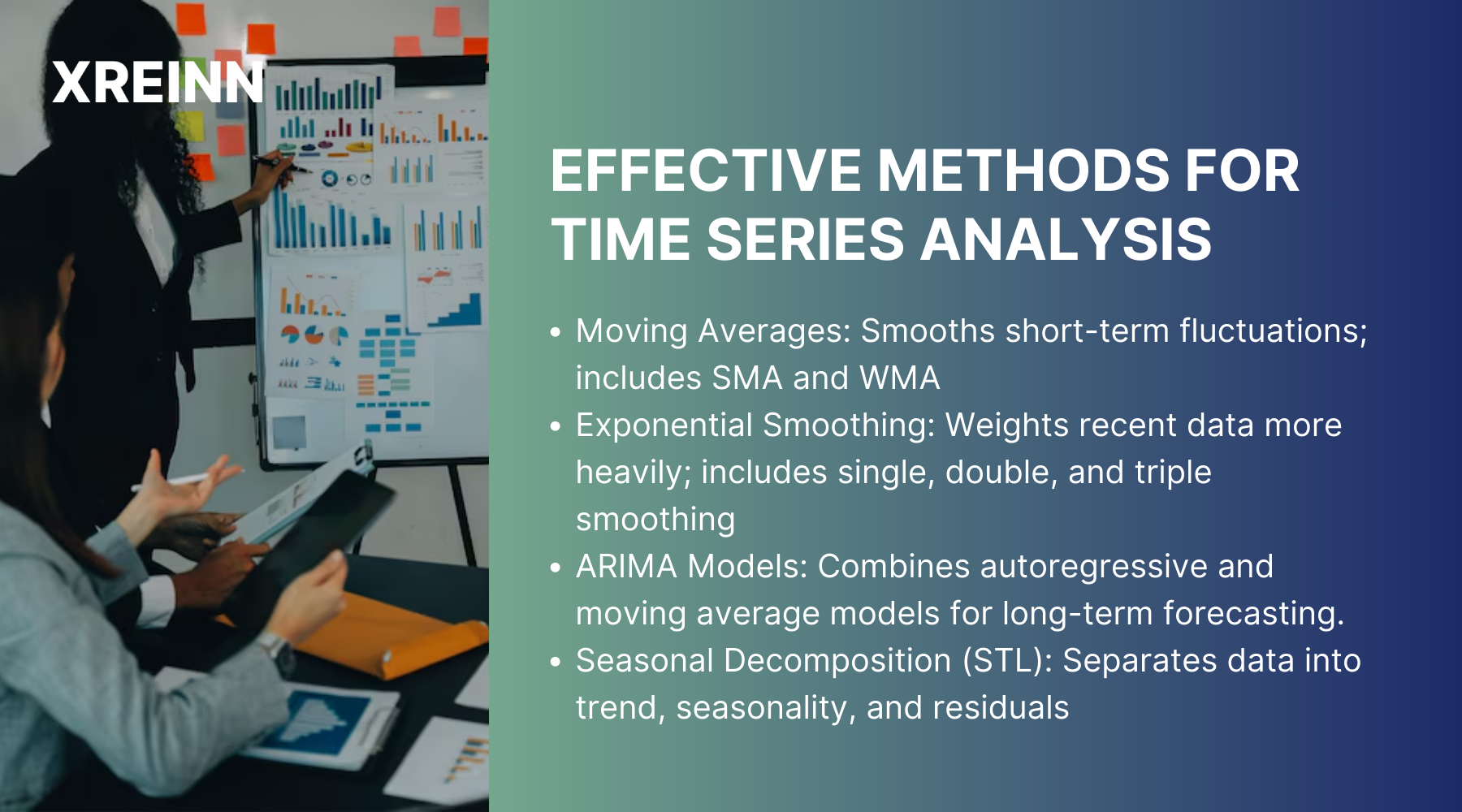Data Analytics
Forecasting Trends, Trend Detection Methods, and Time Series Analysis for SMEs
Jul 01, 2024
Businesses using data analytics are 85% more likely to see improved efficiency and performance. In today’s competitive market, forecasting trends has become a necessity, especially for small and medium-sized enterprises (SMEs).
Accurate trend prediction can be the difference between advancing and merely surviving. Time series analysis is a vital tool, enabling businesses to forecast future trends based on historical data.
This comprehensive guide explores various methods of time series analysis, helping your business to anticipate changes and stay ahead.
Understanding Time Series Analysis
Time series analysis is a statistical technique that analyzes data points collected or recorded by a business at specific time intervals. It helps uncover underlying patterns, trends, and seasonal variations in the data, making it possible to forecast future values.
Typically, time series data is recorded at regular intervals, such as daily, monthly, or yearly. Key components of time series data include trends, seasonality, and noise. By dissecting these components, you can gain valuable insights into your business's performance and make more informed decisions.
Importance of Trend Detection
Recognizing trends early can give your business a significant edge. Imagine noticing an increase in customer demand for a product ahead of your competitors. You could ramp up production or stock before they even realize the opportunity.
Conversely, identifying a declining trend early can allow you to pivot strategies and mitigate potential losses. Neglecting trend analysis can lead to missed opportunities and greater risks. For SMEs, the ability to detect and swiftly react to trends is often crucial for sustainable growth.
Methods for Time Series Analysis

Several methods are used in time series analysis, each with unique benefits and applications. Understanding and selecting the right technique is important for effective forecasting.
Moving Averages: This method smooths out short-term fluctuations and highlights longer-term trends. Simple Moving Averages (SMA) calculate the average of a fixed number of past data points. In contrast, Weighted Moving Averages (WMA) assign more importance to recent data. These methods are especially useful for identifying trends and making short-term forecasts.
Exponential Smoothing: Exponential smoothing methods give exponentially decreasing weights to past data points, emphasizing recent observations.
There are three types of exponential smoothing: single, double, and triple. Single exponential smoothing is used for data without trend or seasonality, double for data with trends, and triple for data that shows both trends and seasonality. These techniques are effective for making accurate short- to medium-term forecasts.
ARIMA Models (AutoRegressive Integrated Moving Average): ARIMA models are versatile and widely used for time series forecasting. They combine autoregressive (AR) and moving average (MA) models, including an integration component to make the data stationary. ARIMA models are suitable for various types of data, making them ideal for long-term forecasting.
Seasonal Decomposition of Time Series (STL): STL separates time series data into three components: trend, seasonality, and residuals. This decomposition helps in understanding the underlying patterns, leading to more accurate forecasts. STL is particularly beneficial for data with strong seasonal variations.
Time Series Modeling
Building a time series model involves several practical steps that are important for accurate forecasting:
1. Start by collecting and cleaning your data. Handle missing values through methods like interpolation or forward filling. Ensure your data is stationary by removing trends and seasonality using differencing or transformation techniques.
2. Choose a model that fits your data’s characteristics. For instance, use ARIMA for data with trends and seasonality, or exponential smoothing for more straightforward datasets.
3. Fit the selected model to your prepared data. This involves using software tools like R or Python’s stats models to apply the model and estimate its parameters.
4. Evaluate the model's performance using accuracy metrics like Mean Absolute Error (MAE) or Root Mean Squared Error (RMSE). Cross-validate by dividing the data into training and test sets to ensure the model generalizes well to new data.
After validation, deploy the model for regular use. Continuously monitor its performance and update it with new data to maintain accuracy.
Predictive Analytics Using Time Series
Predictive analytics uses historical data to forecast future outcomes, helping in data-driven decision-making. In time series analysis, predictive analytics uses past data to predict future trends. For SMEs, this can involve forecasting sales, customer demand, inventory levels, and more. By using predictive analytics, you can anticipate market changes, optimize operations, and improve customer satisfaction.
Tools and Technologies
Several tools and software are available for conducting time series analysis and forecasting. These range from simple spreadsheets to advanced statistical software.
1. Excel is ideal for basic time series analysis and moving averages.
2. R and Python are powerful programming languages with extensive libraries for time series analysis, such as forecasts in R and stats models in Python.
3. Tableau is a data visualization tool that helps in visualizing time series data and trends.
4. IBM SPSS is comprehensive statistical software that includes advanced time series forecasting capabilities.
Choosing the right tool depends on your needs, resources, and expertise. For SMEs, it's important to select a tool that is easy to use with powerful analytical capabilities.
Challenges and Best Practices
Time series analysis comes with its own set of challenges. Common issues include dealing with missing data, ensuring data quality, and selecting the appropriate model. Here are some best practices to overcome these challenges:
Your data should be accurate, complete, and consistent. Clean data is more important for reliable forecasts. Select a model that fits your data characteristics and business requirements. Avoid overfitting by selecting a model that generalizes well to new data.
Regularly update your models with new data to maintain their accuracy. Trends and patterns can change over time, so continuous monitoring is essential. Also, Validate your models using appropriate metrics and cross-validation techniques to ensure reliable and actionable forecasts.
Common Misconceptions
There are several misconceptions about time series analysis that can hamper its effective implementation. Many believe time series analysis is only beneficial for large corporations. However, SMEs can greatly benefit from these techniques by gaining insights that help optimize their operations and strategy.
While some methods can be complex, many user-friendly tools and resources make time series analysis accessible to businesses without extensive statistical expertise. Time series analysis requires patience and continuous refinement. It's not a one-time process but an ongoing effort to improve accuracy and adapt to new data.
Conclusion
Time series analysis is an invaluable tool for forecasting trends and making data-based decisions. For SMEs, understanding and implementing these techniques can provide a significant competitive advantage. By detecting trends early, optimizing operations, and anticipating market changes, you can position your business for long-term success. The ability to forecast trends accurately and make actionable decisions is not just beneficial—it's essential for sustainable growth and success.

Data Analytics
Jun 27, 2024Master key concepts in data analytics with practical tips to enhance decision-making and achieve success in your projects and professional growth

Data Analytics
Jul 01, 2024Learn the essential stages of the data analytics workflow to turn your data into valuable business insights and drive growth.
